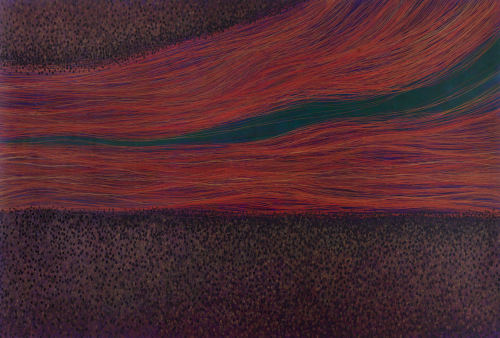
I Want To Be There, Too, 2015, colored pencil, fingerprints and acrylic on canvas, 87 x 128 inches (221 x 325 cm)
Silence and noise. Luisa Rabbia and Emma Hart in Reggio Emilia
By Anna Vittoria Zuliani
December 14, 2017
Love by Luisa Rabbia (born in Pinerolo in 1970) is a collection of introspective images, which through the gaze speak to the soul. It is an exhibition that attracts the attention of the spectator with works on paper and canvas, a site-specific mural and an artist's book. The Maramotti Collection presents a retrospective of ten years of research through which the artist's growth is tangible. From The Within Out (2009) portrays sleeping migrants in a figurative work that describes sleep as a moment of escape and not a dream. Since 2011 the space of the canvas has been defined by thin and vivid marks, similar to red and blue blood vessels. I Want To Be There, Too, instead, brings the mind back to the colors of the Scream by Munch; a crowd of fingerprints portraits anonymous individuals who from one side of the planet to the other merge with the landscape, moving and exchanging energy through an infinite impulse. Here, a pure, inner dimension, emerges as peace and as torment, in other words life. The artist is intimately seeking to find a connection between an inner journey and a physical one, where humans travel crossing lands and borders. Love, part of the Love-Birth-Death trilogy, is the portrait of two bodies firmly involved in an embrace. In the catalogue of the exhibition, Mario Diacono compares these two bodies, crossed by a single spine of arteries and veins, to a Sephirotic Tree which expands in the surrounding void. The image is pure power, it is electricity, it brings into the room the breath of the bodies, floating in the cosmic silence. Luisa Rabbia's nuanced and strong works do not attack, they enter into the mind of the viewer as nerve endings, subtle and deep as the strokes on the artist's canvases.